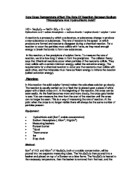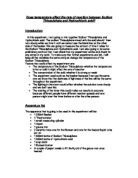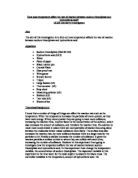Safety:
A pair of goggles will be worn during the heating part of the experiment in order to protect the eyes. An lab coat should also be worn to protect the skin and clothing. When handling hot beakers and measuring cylinders a pair of tongs will be used. A gauze and heatproof mat will be used while heating to avoid any damage to the equipment.
Controlled factors:
The factors I will be controlling are the concentrations and amounts of hydrochloric acid and sodium thiosulphate used. I need to control these because they may otherwise affect the temperature and therefore my resluts would be inaccurate and unreliable. If these factors were not controlled the experiment would not be a fair test.
Variable factor:
The variable factor in this experiment is the temperature of the sodium thiosulphate. This is the factor that I wish to investigate.
Trail experiment:
To find out suitable temperatures to use I will conduct a trial experiment using some extreme values to test how appropriate they are to use.
The table above shows the results I got from my trial experiment. When the Na2S2O3 is cooled to 100C it takes about 65 seconds for the cross to disappear. This would be suitable to use because it has not cooled to the extent where the reaction takes an extremely long time to occur. However, at 700C the reaction happens very quickly and is probably a bit too quick for our reactions to get it as accurate as possible. For this reason I will not use this result.
Next to the temperatures in the table I have written ‘approx’. This is because, with the equipment available it is not possible to get the temperature exactly on the desired figure. In my results table for my final experiment I will therefore record my desired temperature and the temperature I actually achieved.
Now I have looked at the more extreme values I can choose the ones I want to use in my investigation. These are:
-
100C
-
150C
-
200C
-
250C
-
300C
-
350C
-
400C
-
450C
-
500C
-
550C
-
600C
-
650C
Prediction:
I predict that the higher the temperature, the more quickly reaction will occur. This is because with heat, the particles of sodium thiosulphate and hydrochloric acid have more energy. This causes them to move around more. Chemical reactions require collisions, and if particles are moving around more quickly they are more likely to collide. At a cold temperature the reaction will take more time to happen. This is because the particles of sodium thiosulphate and hydrochloric acid will not be moving around so quickly, meaning they are less likely to collide; therefore the reaction will take place in more time.
This means that my graph with temperature against rate, should have a positive correlation, and will probably be curved as the increase in rate of reaction will not be exactly the same as the temperature is increased.
Results:
I was able to implement my plan as presented.
I have drawn two graphs to illustrate my findings. The first is the temperatures plotted against the time taken in seconds for the cross to vanish, and the second is the temperatures against rate. Both graphs have a curved line of best fit, with only two anomalies showing up. Looking at the above table they do not show up as anomalies, but they are easier to recognise on the graphs, as they sit away from the best-fit line.
Analysis:
I conclude that the temperature does affect rate of reaction - the higher the temperature the lower the rate of reaction. I can see this from my table (the lowest temperature has the highest reaction time - 100C took 77 seconds - and the highest temperature has the quickest reaction time - 650C took 4 seconds). I can also see this from my graph.
This is because with more heat, the particles of sodium thiosulphate and hydrochloric acid have more energy. This causes them to move around more. Chemical reactions require collisions, and if two sets of particles are moving around quickly there will naturally be more collisions. However, the collisions require the particles to hit each other at a certain velocity, and if this velocity if not reached then the reaction will just not happen. So, at the higher temperatures, more of the particles were travelling at a high enough speed to collide and react. At the lower temperatures it was more difficult for the particles to collide. Only some were able to reach the required speed and react.
At 100C the reaction took a very long time to occur. This was because there was not very much heat. Heat provides energy to the particles of reactants, and if there is not very much heat, the particles do not have very much energy. Because they do not have much energy they will not move around much, and will therefore not collide very often. Chemical reactions require a certain speed collision to react, and at this temperature very few of the particles collided, because of not moving around more due to lack of energy, because the heat was not very great.
My results and evidence support my prediction very well. They prove the fact that temperature does affect the rate of reaction. My prediction was almost 100% correct, although I did not know that there would be a dramatic decrease in reaction rate on the lower temperatures. So I did make a good prediction.
Evaluation:
The procedure used wasn't that suitable, in my opinion. It was not possible to get exact temperatures, and knowing the point at which to take the temperature was difficult, because as soon as the two solutions are mixed the temperature drops (or rises if cooled with ice). To improve the suitability of the procedure i would also have to take a lot more time over measuring out the sodium thiosulphate and hydrochloric acid, so this would be more accurate.
Also, as the temperature got higher, the results were closer together, and as I had to round the time in seconds to an integer they became less accurate. If I rounded the time more accurately (e.g. to 1 decimal place), my results would become more reliable. Another reason for the higher temperatures being very close together is that the water in the solutions was starting to boil, and therefore change state.
Another way of making our results more accurate would be to take multiple readings and then an average time from these. We didn't do this in our experiment because we did not have the time - had we the time we would have made sure we did this to make the results as accurate as possible. Because we didn't, our results were not nearly as accurate as we would have liked. You cannot really judge from 1 lot of results, because it's possible that something went wrong, or you timed incorrectly. It is quite difficult to judge properly the exact moment that the cross disappears - the human eye is just not strong enough. It is even more difficult for the higher temperatures as you would have to have an extremely good reaction time to stop the stopwatch exactly when the cross changes.
However, my results were consistent even though I did not take multiple results. I only had 2 anomalies, which show up on both graphs. They are not major anomalies, but they sit further from the line of best fit than the other points.
The reason for these could be that it was timed wrong. For all of the results, it was very difficult to start the stopwatch exactly at the same the sodium thiosulphate and hydrochloric acid were put together. They would have already started reacting before the stopwatch was started.
For further work to the experiment, I could try investigating higher tempratures, although the time taken for the cross to disappear would go down a lot less quickly because it is reaching the boiling point of water, and so the water in the solutions starts to boil and turns to steam. It would be very difficult to get to a higher temperature than 1000C. The decrease of the reaction rate would slow, as it got increasingly difficult for the solution to get hotter. To take it even further I could perform the experiment in a vacuum, as then there would be no other factors that can affect our results, other than temperature, which is all that is wanted as the dependant variable.






